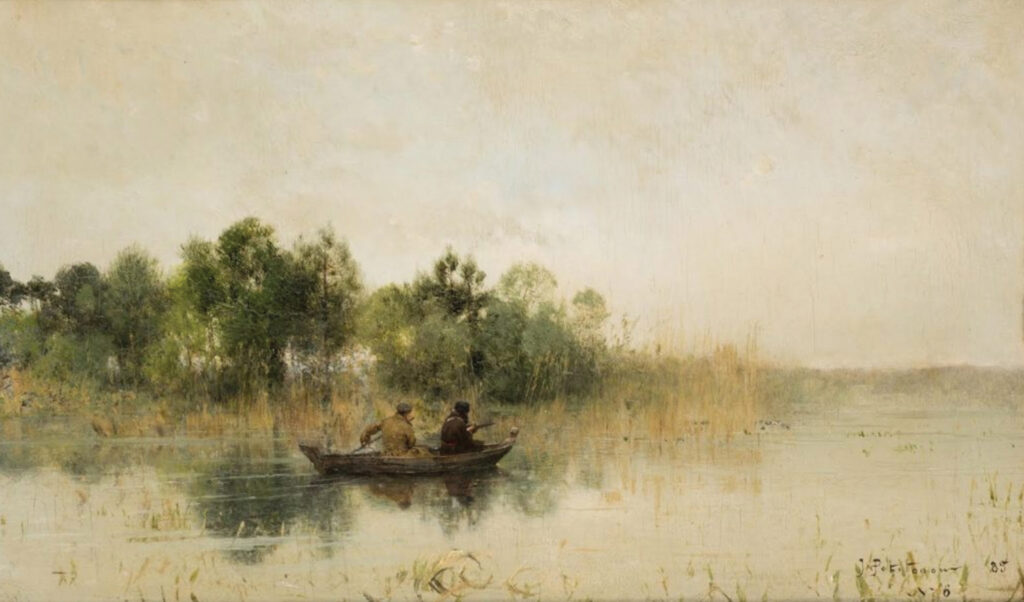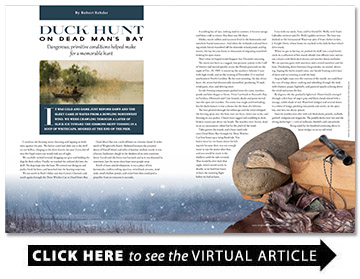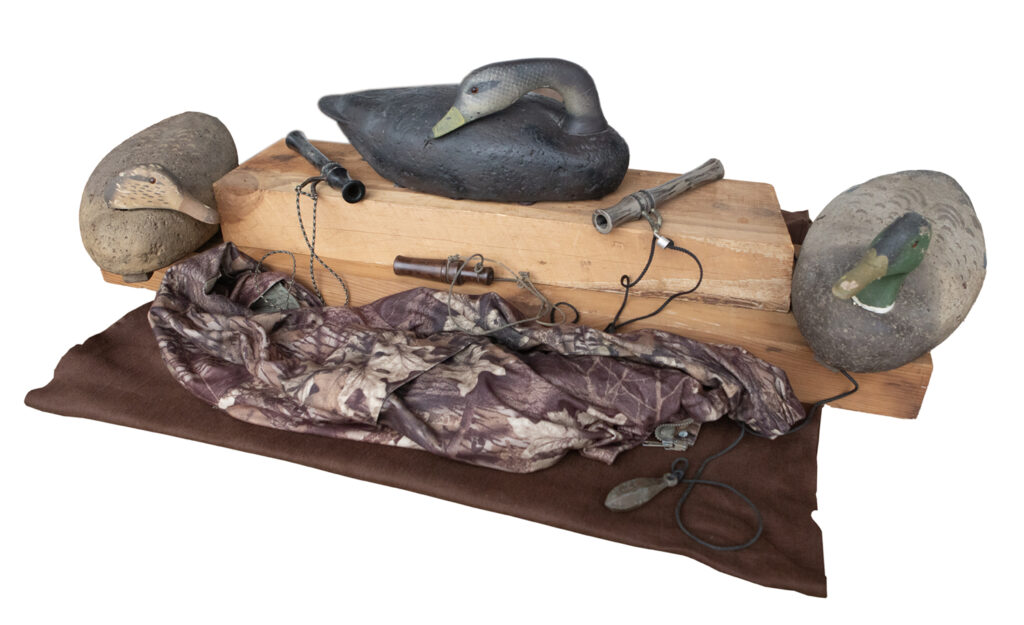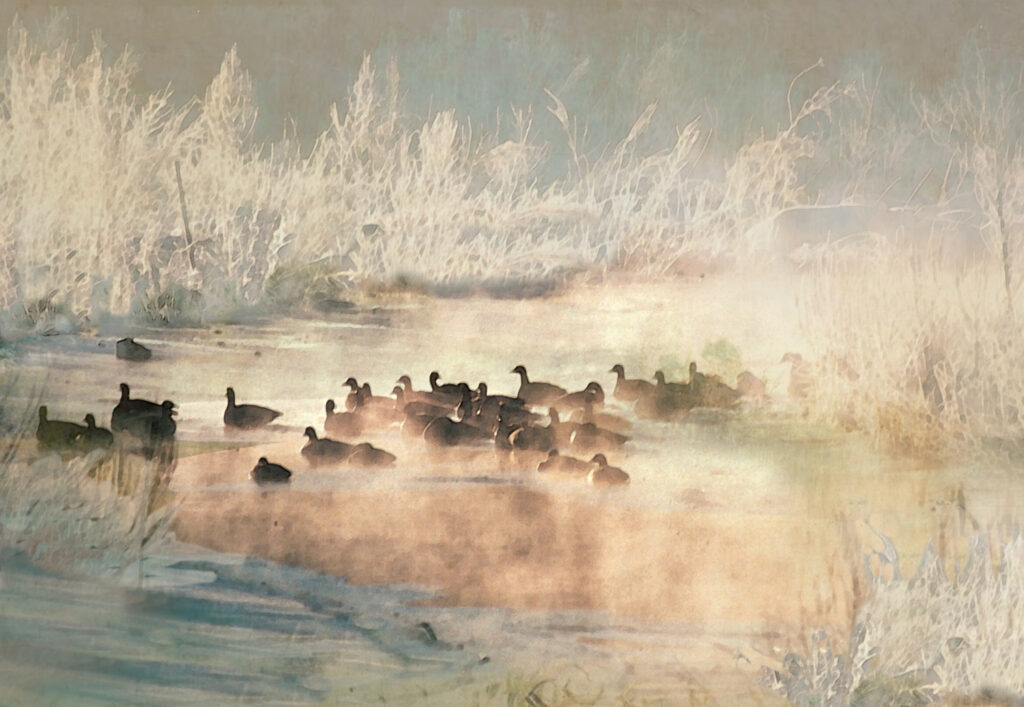Duck Hunt on Dead Man’s Bay
Dangerous, primitive conditions helped make for a memorable hunt
BY Robert Rehder

It was cold and dark just before dawn and the sleet came in waves from a howling northwest wind. We were crawling through a layer of slick ice toward the Simmons skiff tossing in a soup of whitecaps, moored at the end of the pier.
I could see the freezing water churning and lapping on both sides against the pier. We had to crawl and slide out to the skiff on our bellies, clinging to the dock boards, because if you slid off into the frigid water you would sink out of sight.
We carefully inched forward, dragging our gear and holding the dogs by their collars. Finally, we reached the end and slid into the skiff. The dogs leapt into the boat. We stowed our shotguns and packs, freed the lines, and launched into the heaving waterway.
We ran north to Rich’s Inlet, east into Green’s Channel, and north again through the Three Witches Cut to Dead Man’s Bay.
Dead Man’s Bay was a mile offshore on a barrier island 20 miles north of Wrightsville Beach. Sheltered between the pyramid dunes of Hutaff Island and miles of desolate shallow marsh, it was a barren, backwater slough in the shadows of an eerie maritime forest. Locals said the forest was haunted, and so it was shunned by watermen. Just the name alone kept most people away.
Bereft of man and development, it was a place of low hammocks, endless rolling spartina, switchback streams, dead ends, small shallow ponds, and oyster bars that could peel a propeller from its transom in seconds.
A scalding bay of ripe, sinking mud in summer, it became savage and bitter cold in winter. But there was life there.
Minks, marsh rabbits and raccoons lived in the hammocks and somehow found sustenance. And when the wetlands iced and freezing winds forced waterfowl off the shoreside inland ponds and big waters, the bay became home to thousands of migrating waterfowl looking for open water.
That’s what we hoped would happen that December morning.
The storm was born as a ragged, low-pressure system in the Gulf of Mexico and moved quickly across the Florida peninsula on the night of Dec. 20, 1989. It roared up the southern Atlantic Coast with high winds, and on the evening of December 22 it reached southeastern North Carolina. By the next morning, the day of our hunt, the storm had dramatically intensified, producing 50 mph wind gusts, sleet, and driving snow.
As sub-freezing temperatures pushed onto the coast, marshes, ponds and lakes began to freeze. From Currituck to Buzzard’s Bay, in Pamlico, Albemarle and Core Sounds, ducks and geese moved into the open salt marshes. The storm was rough and foreboding, but for duck hunters it was a chance for the hunt of a lifetime.
The boat plowed through the whitecaps and the wind whipped the freezing spray over the bow, into our faces, down our necks, and freezing on our parkas. Clouds were ragged and scudding in dark, broken masses just above our heads. The marshes were frozen, dead in an icy encasement, silent but for the pitch of the wind.
Tides govern the marsh, and a boat could only enter Dead Man’s Bay through the Three Witches Cut four hours up a rising flood tide. You had to leave by two hours down the falling tide because there was not enough water to run the motor after that, and you would be stuck in the shallows until the tide reversed. That would be after dark that night, which would surely be deadly, so we had four hours to hunt the morning flight before we had to leave.
I was with my uncle, Stan, and his friend Dr. Wells, with Stan’s Labrador retriever and Dr. Wells’s golden retriever. The boat was docked on the Intracoastal Waterway pier of Stan’s father-in-law, J. Knight Davis, whose home we reached in the dark by four-wheel-drive truck.
When we got to the bay, we pushed the skiff into a small feeder creek in a collection of low marsh islands that offered cover and set out a dozen cork black duck decoys and another dozen mallards. We cut spartina grass with machetes and covered ourselves and the boat. Hunkering down between the gunwales, we waited, shivering, hoping the ducks would come, our breath frosting and a layer of snow and ice covering us and the boat.
As gray light crept over the vastness of the marsh, we could hear the roar of wings above, rushing and whistling through the dark with chatters, peeps, highballs, and guttural quacks echoing down the wind and across the bay.
By degrees, the sky gradually lightened. Dawn finally emerged through a dim haze of angry gray and black clouds tinted with a strange, subtle shade of red. Waterfowl dodged and weaved down in a whirr of wings, pitching into ponds and creeks, in the open bay, and into our decoy spread.
Soon the marshes were alive with teal, black ducks, pintails, mallards, gadwall, widgeon and ringnecks. The puddle ducks were low and the diving ducks high — rafts of redheads, bluebills and canvasbacks flying south by the hundreds jockeying above in loose wedges on an icy tail wind.
Five black ducks came spiraling down from the clouds, wings banked and braced against the wind, feet down, curling into the decoys. The guns went up booming and flames cracked and flashed in the early light. The dogs leapt for the retrieve and dove into the frigid bay, as they would many times that morning. All the while ducks circled overhead, and the sound of wings never ceased.
Pintails banked high and fast over the spread while mallards poised feet outstretched above the decoys. With a loud rush like tearing cloth, a mass of bluebills circled out over the marsh then peeled into our decoys, feet dangling.
A mixed flight of gadwall and widgeon decoyed from the ocean, over the marsh behind us just feet over our blind.
Green-winged teal rocketed through the spread all morning, sometimes before we could even get our guns up. Elegant, snow-white tundra swans, their long necks outstretched, whistled far above us. Three Canada geese came honking down the freezing waterway, floating to our decoys, and soon after two flocks of brant that we had not seen on our coast before.
By 9 a.m., the morning flight was over other than a few high flocks, and we had our limits. The wind increased and the temperature plunged. We were exhausted, dangerously cold, and close to hypothermia. The tide had flooded and was dropping rapidly, and it was time to leave while we could.
We gathered the decoys, which were covered in ice, and pulled the skiff from its hide into the bay over skim ice that had formed during the hunt. In a matter of hours, most coastal waters would freeze solid and drive all the ducks south to warmer haunts.
It had been a miserably cold, windy, sleet- and snow-driven day, but it was the hunt of a lifetime that would never happen again. The lasting vision I have is the two brave retrievers standing side by side in the lee of the Simmon’s skiff as we made our way back to shore with our limits of ducks, geese and brant stacked on the deck.
Thirty-five miles away in Wilmington, the wind began to gust at hurricane strength, and a record snow accumulated to 15 inches in a 24-hour span. Along the entire North Carolina coast, snow amounts ranged from 10 to 15 inches and gusty winds piled drifts 4 to 8 feet high. It was the first white Christmas on record for coastal North Carolina.
During the storm, low temperatures reached 0 degrees in Wilmington and -5 in Jacksonville.
We hunted that morning in a place that was still wild and free and subject to the raw power of the elements. We would never again see such a coastal storm, the numbers of birds, or hunt the primitive bay. But that morning, two beautiful, brave dogs and thousands of waterfowl flying through a gale of ice and snow gave us the finest duck hunt of our lives on Dead Man’s Bay.



